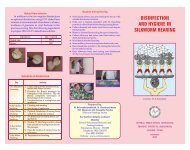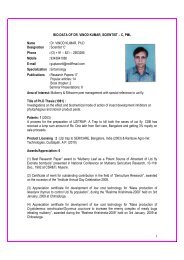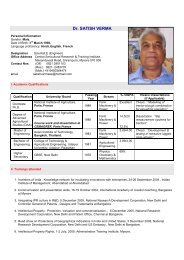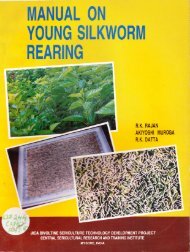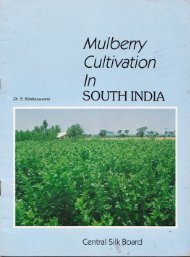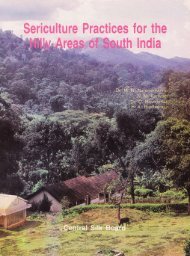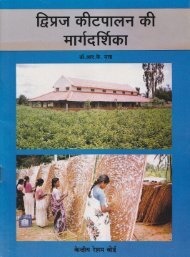-t
Young Age Silkworm Reaaring Trainer's Guide - Central Sericultural ...
Young Age Silkworm Reaaring Trainer's Guide - Central Sericultural ...
- No tags were found...
Create successful ePaper yourself
Turn your PDF publications into a flip-book with our unique Google optimized e-Paper software.
vl<br />
Yotlt o.[GI rsr uifilof,-u nilnnnt<br />
-t
YOI'NG AGE SII,KWORM REARING<br />
TRAINER'SGI'IDE<br />
by<br />
Sri R. Gururaj<br />
Dr. S. B. Magadum<br />
Editor<br />
Dr. S. M. H. Qadri<br />
$ ll<br />
/s7<br />
2009<br />
Regional Sericultural Research Station,<br />
A Unit ol CSR & Tl, Mysore, Cenlrat Silk Board,<br />
Govt. of lndia,<br />
Chamaraianagar-571 31 g
FOREWORD<br />
The Sericulture is an ago based indusry catering<br />
weaving communities ofcounhy. It is<br />
Dr. H. BASKER,I.A.S,<br />
Commissioner for Se culture,<br />
Gort. ofKamataks,<br />
Bangalore<br />
ffi) \44/<br />
the needs of mainly farming and<br />
vm ptoor,<br />
Multi Stored Bldg<br />
Dr. Ambedkar Veedli.<br />
Brngalore - 560001<br />
Date: 241h March 2009<br />
esrimared that ov€r six mi ion peopje are dependert<br />
on the sericulrure actjviries for rheir livelihood. The new sericulrural technologies have<br />
revolutionized the producrion and producrivity of both mulberry and silkworm jn selected parts<br />
ol Andhra Pradesh, Karnataka & Tamilnadu. Therefore, the tmining and demonstration of<br />
various technologies fo. disease free and assured cocoon production particularly young age i.e,<br />
chawki rearing technology are essential ro brjng about revolution in other pans of rhese<br />
imponant sedcultural states of India-<br />
It is in rhis conrexr, I am happy ro leam that Scientists of CSB have brought our an<br />
excellent compilation enritled 'ryoungage Silkworm Rearing - Train€rs cuide',, which will<br />
be useful to the Studenrs, Teachers, Farmers, Extension functionaries and Officers alike.<br />
The compendium deait with all the activiries of chawki rearing on day to day basis and<br />
also included the pre and posr evaluation of rrainjng which woutd help rhe tminees io improve<br />
their knowledge and acquire the operational skills ro ger successful cocoon crops. I arn certain<br />
that ihe compendium would be higlly relevant to produce skilled manpower required rowards<br />
reaching the desired level ol production of silk in the counrry and to tufiher augment the<br />
income of the sericulturisrs.<br />
I, whole hearredly, congraiulate lhe efforts iaten by the autbors in bringing out this<br />
compendium at an appropriate rime.<br />
F \la - './<br />
commEsioner dserbut!-rtD.vt<br />
& Directorj+ Saibutur. _
PART ONE<br />
INTRODUCTION<br />
Knowledge of basic corlcept of young age rearing is vital<br />
aspect in sericulture industry for ensuring good cocoon quality.<br />
This is emphasized amply in present training course in which<br />
the trainer will apply the participatory diagnosis of problems<br />
related to young age silkworm rearing and practical session in<br />
rearing robust disease free worm .The objectives are to equip<br />
participants with knowledge and skills that should enable them<br />
to:<br />
1. have proper incubation and good healthy hatching<br />
2. ensure robust and disease free growth of young<br />
silkw orm<br />
3. reduce the larval mortality to improve the yield<br />
4. reduce production cost & utilizing saved labour for<br />
other activity by consumers.<br />
The recommended duration for conducting this course is<br />
eight days with three hours for practical session as detailed<br />
in the table.
A. DETAILS OF DAY WISE SCIMDULE TO BE COVERED IN<br />
YOI]NG AGE TRAINING PROGRAMME<br />
Day FOR,ENOON AFTERNOON<br />
I Reporting& Handling & transporting of silkword eggs, leaf<br />
moisture estimation, brushing arrangement,<br />
requirement of readng house for chawki- creating<br />
microbe free environment & disinfection and its<br />
imDortance<br />
2 Brushing Calculation of hatchingTo, Impofiance of<br />
silkworm hybrid rcaring incubation, black<br />
boxing& time of brushing, number of feed,<br />
selection of leaf and feeding habits<br />
3 Attend rearing Chawki garden - planninB; package of practice,<br />
pruning methods, disease management during<br />
4 Fieldvisit Moultinq care<br />
5 Resumption of<br />
wonns fromlsr moult.<br />
Silkworm disease & pest of young age and it's<br />
management ,use of bed disinfectant (theory)<br />
application of bed<br />
disinfectant<br />
6 Attend Rearing Importance of commercial Chawki Rearing<br />
Cente6& main€nance of temperatore, humidity<br />
and hvqiene(theory)<br />
,7<br />
Attend Rearing Testing of chawk worm and Certification. Care<br />
for transportation of worms.<br />
8 Silkwom rearing Evaiuation of training pmglamme and<br />
presentation of Certifi cate.<br />
The trainer shoutd go through the following check lisl for murse<br />
prepararjon and delirery belore hand.<br />
1. Venue: Training Venue should be within lhe campus having a separate<br />
chawki rearing house & chawki mulberry garden for practical<br />
demonstration. ldentify a suitable room before hand.<br />
2. Date of tmining: It should be decided and informed to partioipants in<br />
advance taking into consideration the readiness of chawki leaf and date<br />
of hatching of silkworm eggs on the date so fixed for training<br />
3. Arrange for Audiovisuals, OHP etc., and also food oi snacks to be<br />
served at an apprcpdate time.<br />
4. Training assistants: Tfuee t ainers ie., a head trainer and tvr'o assistants<br />
are ideal.
5. Preparation ofteaching matedals: Ensule the course teaching matedals,<br />
such ssrBooks/bulletil for chawki rearing, flip chrrts, felt pens, white<br />
bi blackboard, note books, over head projector, audlovisuals are ready.<br />
CD's on you+g age rearing can also be used.<br />
6., Prepare materials for practical Exercises: Ensure requircd Eaterials as<br />
per check memo are ready for practical exercise before practical<br />
session.<br />
B. CEECK MEMO FoR YOUNG AGE REARING : MULBERRY<br />
CHAWTiGARDEN:<br />
Aroa as per requirement (say % acre uit)<br />
1) Mulberry variety Vl or536<br />
2) Spacing : 3' X 3'<br />
3j hiigation :35,000 gallon/ha,/edch time (4-6 days once)<br />
4) Packag€ ofpracticas as per recommerdation 260N: 140P:140K,41a<br />
. 5) FYM 40 MT in two split doses.<br />
6) Training ofMulberry: (Scrops/plot/year, as per .ecommeldation).<br />
?) Us€ ofbio-fertilize$ depending upon soil nutrients.<br />
C. YOIINGAGE REARING: EQUIPMENTS AI\D INPU"rsi<br />
1. Rearing house compact, cement floor, plastere.d & isolated.<br />
2. Size ofrearing house as per requiremeqt (based on brushing capaci9<br />
3. Plastic rearing Trays 3'x4' (20 Dfls ffray)<br />
4. Rearing stand (20Trays/stand)<br />
5. Feeding stand as per requirement<br />
6. Afl weU: (4antwell/stand.)<br />
7. Povler spnyer - one.<br />
8. Mask - one.<br />
9. Lime.3-4 kg. /readng of2500Dfls.<br />
I 0. Vijetha-34 kg /rearing of 2500 Dfls,<br />
1 1. Bleaching Powderl.5 - 2 kg /rearing of2500Dfls.<br />
12. Saritech-2.o literhearing of 2500Dfls.<br />
13. Humidifier: as per requiement & ne€d.<br />
14. Plastic bucket, Basin & Mugs<br />
1 5 . Famff!4 or Blue Polythene sheets (8- I 0o./l ooDfls)<br />
16. Chop sticks (8-10 pairs)<br />
I7. Feathers<br />
18. Old news pap€$ (2.5 - 3.5 kgl100 Dfls)<br />
19. Black sheet & tissue paper as per rcquirement.<br />
20. Black cloth 1.5 m.<br />
2 I . Gurny cloth as per need.<br />
22. Com cloth as per need.<br />
23. Incubation frame: @ ore egg case of50dfls (in case ofloose eggs)
D. Silkworm Eggs.<br />
Disease free layings as per rcquir€ment of Eaining pro$amme<br />
should be brought thrce days earlier and incubated properly and subjecting<br />
eggs to black box for 48 hours. Black boxing should be done pior t6<br />
brushing, Rearing room should be thoroughly washed. along with<br />
equipments and disinfected. prior ro silkworm incubation. Amange lhe<br />
requiibd trays wirh blue polythene sheets atrd keep the loose egg spriad on<br />
lncubation Fames or egg sheers suitably spread and is covl-rei with a<br />
tiolytbene sheet and a sheer of black paper. Maintain rhe reauisite<br />
temperature and humidiry for incubation i.e., 2/ - 280C and 80 % r;ladve<br />
humidity. Explain ftem, importance of maini€nance of room iemperature,<br />
hunidity ard along with reference to care.of disinfcction (prevention).<br />
Ensure that all thdse were done in accordance of incubalion ofeggs before<br />
. brushing, so as to facilitate the tainees for brushing of works as per<br />
programme (Fig. l)<br />
adequale copies of pre evaluation forms as to knJw lleir pre-<br />
-Make<br />
knowledge about their technology expertise about the incubation &<br />
brushing,<br />
E Cbeck list for course preparation:<br />
D C1rcck list course delivery.<br />
> Conduclparticipatory introduction.<br />
> Start firsfsession on day I with participatory introduction after<br />
participant's registration.<br />
Box I. Examples ofqu€stiotr to ask duritrg particip.tory itrtroductiotr:<br />
. What is your.nams ?<br />
. When did you 6tsit sericultue?<br />
o What is the quantiry ofdfls you rear & tour mulberry acleage?<br />
. Whether you have irrigalion facility?,<br />
. Why you are attending the Training programme?<br />
. w1lar do you hope !o get fiom fte course?<br />
. What is the yield ofyour cocoon crop?<br />
. How many terhnologies do you praptice?<br />
Ask the participant to fill the details based on the said back ground and<br />
experience. Elicit what they need before explaining otijective oftraining
Box 5: Examples ofrules set with participants!<br />
. All lhe session mu5t stan puncrually afler relting Ljme lo slan.<br />
. Active participation by every one.<br />
. Every one to altend all the sessions.<br />
. Re.pect each other\ opinion.<br />
F. Conducting discussion:<br />
As for as possible anange daily instruction fid discussions. Elicit<br />
response to various questions from the participants and arpreciate those<br />
responses that arc corect.<br />
G. Evaluation at lhe end ofeach day:<br />
At the end of each day the Trainer should assess the value of<br />
sessions covered by asking the pafiicipants to list they bave leamt.<br />
Ensure active parlicipation in praclical exercises:<br />
Ensure active participadon of all active pafiicipants in the chawki<br />
rearing begindng from incubation, black boxing, brushing, selection of<br />
quality leaf, chopping of leaf, till feeding to chawki worms on each<br />
practical sessions.<br />
II. Review all sessions.<br />
At the start of each day review all sessions delivered on the previous<br />
day, before starting the day sessions. Discuss all the carcs to be taken on<br />
each day and also difficulties faced if any.<br />
Conduct the post eyaluation exercisei<br />
This is to help obtain a permanent record, judge whether cource<br />
objective have been achieved, and to develop and improve your training<br />
approach and materials. (Annexure-1 1)
. PART TWO<br />
TRAINING GUIDE _ YOUNG AGE SILKWORM REARING<br />
The following part of the training manual comp ses the course contents<br />
and Training methodologies in the form of Trainers guidelile. The<br />
guidelines are segregated day by day session, and activities to be<br />
conducted in each session. Trainers and participants will have an abridged<br />
(smaller version), which includes some of the Text arld all illustrations to<br />
be used during Trajning Program.<br />
Day l:<br />
To equip the participants with background knowledge on course of chawki<br />
rearing.<br />
Session 1.1<br />
Introduction to the Training Program<br />
Objeclire for this session,<br />
'<br />
To create a friendly learning environment through self introduction of<br />
participants.<br />
To elicit hopes fea$ & expectation ofparticipants.<br />
' To set the g.oulld rules.<br />
To explain the impofiance of chawki readng in Sericultur.<br />
. To explain the aim & objective of whole course.<br />
Activity: 1.1.1. Introduction of participants.<br />
Specific objective: To create open & friendly leamitg environmeft in<br />
which every one is encouraged to padcipate.<br />
Actiyityr 1.1.2. Eliciting hop€s fears and expectation.<br />
. Participants should introduce themselves & sign in attendance sheet<br />
and issue pens & training manuals & folders.<br />
. Ensure expression ofparticipants feeling about tnining and elicit their<br />
participation of ftaining & record the comme;ts and their<br />
expectation from the training.<br />
1,1,3. Setting the ground rules:<br />
To ensure consensus and agreement on the conducting of the training<br />
progr,un.<br />
13
Activities Resources:<br />
Present the Time Table of T@ining prcgmmme.<br />
1.1.4. The importance of Training Program<br />
Present the time table with contents of each sessions and time breaks.<br />
Activil): L1,4. The impoflance of Chawki Rearing<br />
Specific objective: To bring awareness of chawki rearing in siikworm<br />
Rearing.<br />
Young age worms grow fast and have resistanct to high temperafure<br />
(26-28'C.) high humidiry 80-8570, low air circularion nnd highly susceptibte<br />
to diseases.<br />
^ Why Training on Chawki rearing is felt relevant N a key aspect in<br />
SiLk\ orm rearing forcocoon produclion?<br />
Actiyities Resources: - Discuss importance of chawki rearing training and<br />
their importance in Silk production.<br />
Why Chawki Rearing is considered as integal part of Silkworm<br />
Rearing following feed back second queltion.<br />
Wly should Training hograms in Chawki Rearing be important to<br />
you?<br />
Facilitator record pafiicipant response.<br />
The Cocoon marketing chain (Annexure - 1)<br />
Relating causes& effect!<br />
. Quality silkworm for cocoon production.<br />
. Quality silkworm for disease freeness.<br />
. Quantiiative aspect per unit ol 100 Dfls.<br />
o Maintenance of Chawki silkworm rearing for disease freeness.<br />
. Maintenance of Chawki silkwom rearing for prevention of disease<br />
occutence.<br />
. Maintenance of Chawki silkworm with adequate feeding for quality<br />
Sill producrJons.<br />
. No mortality - high prcduction, retention of their .acial characters &<br />
maximum silk production per unit.<br />
. Healthiness of larvae ensure imptoved silk yield by silkworm rearers to<br />
get confidence of silk reelers.<br />
. Improved consumer yield: increased yield/ 100 Dfls to get patonage<br />
elc.
Chawki Rearing Centre and its consumers:<br />
Importance of Chawki rearing rraining on Silkworm crop yield &<br />
quality:<br />
. Examples ofresponses from pilot training exercise.<br />
. Entrepreneurship & Employment generation.<br />
. Chrwki worm handling is delicate and needs hygiene<br />
o Make Chawki reared wo1m accessible.<br />
. Assist poor farmers with healthy chawki rearing.<br />
. Economics and management of CRC.<br />
Activiry 1.1.5. Aims anal objective of whole course,<br />
Specific objective: - To explain the objective of eight day tuaining<br />
programme.<br />
Plenary discussion: Ask the pafiicipants what they think, aims of<br />
chawki rear.ing importance in quality silk production. Record the response on<br />
an A20 sheet present chawki rearing cenhe, late age rearing, marketing (silk<br />
reeler).<br />
Marketing chains: how can each ofthe stakes holders get benefit?<br />
Present the aims and objectives of the progrars on over head tmnsparcncy<br />
A20 sheet, flip charts and marker pen and over head projector.<br />
Session: L2,<br />
Factors relating to brushing allangement, egg hanspo ation,<br />
requiremenl of rearing hou,e irs rppliances. leaf qualiil moislure esdmation<br />
and impoft ance of disinfection.<br />
1.2. Activity resources: - Disinfection (practical & theory)<br />
L2.l: Importance of Disinfection<br />
Objectiye of this session.<br />
To appreciate the importance of disinfection in chawki rearing & use of<br />
eco friendly disinfectants.<br />
ActiYity:<br />
1 Disinfection of chawki Rearing house, & appliances& its surroundings.<br />
2. Quality ofdisinfection solution required for spray.<br />
3. heparation of disinlectant solution. (Fig 2 & 3)<br />
To create awareness of disinfection in chawki rearing and appreciate<br />
various disinfectant available and ensure the participants for the use ol eco<br />
friendly disinfectant for the disinfection. Explain with flip chart showing<br />
(annexure-6) schedule to be followed for disinfection.<br />
15
A.wareness of disinfection:<br />
L To de.troy lhe hamful baclerial / \irus.<br />
2. It should be eco friendly and not handul to human beings.<br />
3. Only recommended disinfectants at proper concentrations be used for<br />
good results without affecting the chawki silkworm.<br />
4. Don't allow the appliances to bi smeared with cow dung as the source<br />
of infection either with bacteria / virus, which was common practice<br />
5. Allow the appliances/equipments for surl drying before p.eparation of<br />
disinfection.<br />
1.2.2; Preparation of disinfections: -<br />
To enable the participants to prepare the quantity of disinfectant<br />
solution required for the space of chawki room, ask the participant to disinfect<br />
the arca measured.<br />
Check the disinfected area with litrnus test to ensure the through disinfection.<br />
1.2.3: Materials : Dfls sheet / loose eggs, incubation frame,-blue polythene<br />
sheets, black sheet, egg hansportation bag, hygrometer.<br />
Back ground: There are many constraints or problems for egg<br />
hansportation availability of suitable chawki rearing house, leaf quality. This<br />
includes<br />
. Long distance from egg procurement cenfue to chawki center.<br />
. Mishandling of silkworm eggs, by not providing rcquisite temperature &<br />
humidity.<br />
. Unhygienic trMsportalion & of eggs.<br />
. Improper preservation/transportation of eggs due to lack of training.<br />
. Requirement of quality leaf for chawki rearing.<br />
. Inadequate space & environment for chawki rearing.<br />
All these factors relate to undue atmosphere for chawki rearing, lead to<br />
loss of silkworm crops, & also l€ad to failure of silkworm crops thai result<br />
in economic loss.<br />
In taining session,. the fatmer can discuss on these constraints with<br />
examples enabling them to rectify their technology in handling the eggs.<br />
1.2.4: Egg Handling<br />
Activity resouices:-<br />
Explain the handting of eggs, carying them disinfecred egg<br />
transportation bags dudng cooler hours with requisite temperature & humidiit<br />
(807o). presenation of egg /dfls on single laler ir disinfecred rrays in<br />
belween blue pol)lhene sheers incubarion r27n C &g0 % RHt. In plenary<br />
group: Discuss briefly their rcle and function and care to be taketr in handling<br />
olsilkworm eggs. (Fig 5 i
1.3 Selection of Chawki Leaf for brushingt-<br />
1.3.1 Selection of Chawki laaf for bmshing:-<br />
Specific objective: requirement of quality leaf for young age silkworm and<br />
producrion olqucliry leaf.<br />
Materials: chawki garden (ready for brushing) chart depicting pruning &<br />
harvest chawki leaf & haNest schedule<br />
1.3.2: T.aining of Mulberry<br />
Activity resources:-<br />
Explain the training of mulbeny chawki plot for eight leaf harvest schedule by<br />
bottom pruning as well as top clipping: (ADnexure -2)<br />
1.3.3. : Chawki Plot<br />
Back ground:<br />
Exclusive Chawki plot are nor maintained by the Sedculturist. Chawki<br />
plot are not properly maintained and hained by the farmers, which requires<br />
sp€cial attention with regard to input of both organic and inorganic fertilizers<br />
do"e". as \ ell a. rncinlenance of soil heallh. The same has been exploired b)<br />
the farmers without substituting adequate the organic & inorganic matters<br />
Young age worms are resistant to high humidity & highly susceptibte<br />
to diseases. Hence quality leaf with higher moistue content should be<br />
selected. (Annexure 3)Therefore this session is designed to provide relevant<br />
knowledge and skill needed for maintrenance of chawki plot. application of<br />
inorganic & orgaoic fertilizer, as well as proper irrigation, so as to produce<br />
the qualily leaf for young age. Show the schedule for training of mulberry &<br />
selection of leaf for chawki (Iig, 7 and Annexure- 8)<br />
1.4: Actiyity: Brushing Arrangement in Chawki rearing room<br />
1.4.1: Arrangement of room appliances<br />
Specific objective: To enable the pafiicipants to understand<br />
. Type & size of rearing house with leaf stomge, also to rnaintain<br />
temperature & humidity sufficient light & flow of air.<br />
. Chawki rearing appliances viz., plastic rearing trays, blue polythene,<br />
sheets, rearing stand, leaf chopping board, leaf chopping knife, cleaning<br />
nets, leaf preservation chamber & baskets. feathers, chop stick as per<br />
requirement, e isted in check memo.<br />
1',l
1,4.2: Young age worms physiological parameters<br />
Activities resources:<br />
Discuss nuintenance and selection of chawki room; as the young age<br />
worms gaow fast and has resistance to high Tempetature & high humidity,<br />
rather requires low air circulation and susceptible to diseases.<br />
Trainer can explain with flip chart tlre physiological activities during<br />
young age silkworm<br />
. Young age silk worm especially du ng I insiar has very high growth<br />
rate 15 times, where as grcwth rate dudng II instar is only 5 times.<br />
Young worms in both instars has low resistance against ;uritional<br />
deficiencies however growth duration is faster in II instar (2% _3<br />
days) when compared to I instar (3yr- 4 days).<br />
1,5: Efrect of temperature & humidity growth of young age silk\yorm<br />
1,5.1: Effect of temperature & humidity growth of young age silkwo.m should<br />
be emphasircd with flip char1. (Annexure-s)<br />
. Trainer can explain newly hatched larvae has low water content but<br />
once it stafts intake of mulberry feed rapid increase in water content<br />
76-797" (I in srar) to 83 - 84Zo([ in star).<br />
. .Young worrns have low percent of ingestion (25qr) in tems of intake<br />
of mulbenl feed but digestion is comparatively high.<br />
. Trainer can explain with flip chart food requjrement of young age<br />
worms which needs more of carbohydrate (147,) an
a) Use a play full game to involve all participants in recapping the main<br />
learning points from Day 1. A11 stand, one facilitator passes the ball in<br />
tum to participants who state what they have leamt during the day<br />
whilst other trainer records the leaming points on A 20 sheet.<br />
Eacb participant is then given a post- it sheet to \\,Tite comment about<br />
Day 1& stick it on the prepared A 20 sheet.<br />
. In the 'happy" section if they are pleased.<br />
. In the'heutral" section if they are indifferent and<br />
. In the "sad" section if they are disgruntled.<br />
After participants depart and trainer remain there to conduct their own<br />
debriefing and assess the participants evaluation coinments A 20 sheets, flip<br />
charts, marker pets and a ball A 20 sheet with ,happy": ,,neufal,, &'.sad,,<br />
post it pads<br />
Session: 1.6: Pre evaluation on knowledge of chawki rearing<br />
Objective for this session: To obtain back ground information about the<br />
padicipants for .ecord purpose including assessment of the impact of taining<br />
al a later dale.<br />
Activities resources<br />
Ask palticipants to complete the pre-evaluation questionnaire beforc the<br />
stafi ofday 2.<br />
Many participants find completing this kind<br />
and therefbre it may be deemed unnecessary,<br />
session.(Amexure - 9)<br />
Day 2:<br />
Session2.l<br />
Introduction session to activities of Dav 2.<br />
2.1.1: Objectiye of this session:<br />
of questionnaire diffi cult<br />
in such case omit this<br />
To get all participants focused and ready up for day 2.<br />
Actiyity Resources: Feed back from day I and coDments dayl evaluation,<br />
and summarize the ma;n learning points of dayl, the preparation of rearing,<br />
.rrangements of appliances, egg preservation. Explain the day 2 programme.<br />
Session 2,2<br />
Importance of incubation & Black boxing (practical)<br />
Objective:- To enable the participants to know the impoftance of incubation<br />
and black boxing of silkworm eggs; brushing of silkworm eggs.
2.2.1. Brushing (Practical Session).<br />
Procedure: - On the day ofbrushing, remove the eggs (dfls) from black box<br />
and expose tlem to natural lighydim light (15-30 Lux) for 2-3hour, atl the<br />
eggs will hatch uniformly (Fig.6 & 8)<br />
Take the pa{icipants to chawki plot ask them to select & pluck tender<br />
leal in cool hours and quanriry ia, per requirement.T and c, llecl i; dirinlecled<br />
bamboo barket co\er the moulh ofbasket \\id \ el clorh.<br />
. Ask the participant to arrange leaves with petiole on ore side, demonsftate<br />
cuuinB ol leal to lhe si,/e 0.5-2.0 .q.cm alter removing perio.q. r fig.ar<br />
. Trainer can explain the use of leaf chopping machine for commrcial<br />
chawki rearing to save labour mandays. (Fig.t3)<br />
. Ask tha participants to spdnkle chopped leaf on egg sheevincubation ftame<br />
. .where loose eggs were spread covered with brushing net within l/2_2 hrs.<br />
ail the hatched larva will start feeding on chopped leaves. (fig10)<br />
. Trainer can enlighten them that newly hatched silkworm feeds only on<br />
juice i.e., sucking through its proboscis (mouth part) later starts carvins<br />
and linall) cul. rhe chopped lea[.<br />
. Transfer the hatched worm to the prepared rcaring tray with paraffin paper<br />
or blue polythene sheet for the rearing bed (Fig. 1l)<br />
. Ask the participants to avoid manual handling of hatched larvae, instead<br />
ask them to use soft feather/ tapping, to transfer to reaaing beds.<br />
. Instructor to show flip chart with regard to standard spacing to be provided<br />
at the time ofbrushing of 100 Dfls.<br />
. Ask ft€ palticipants to provide bed spacing as per the quantity ofDFLS<br />
based on flip chafi. At the time ofbrushing (100Dfls) ,50,00d larvae)<br />
l't Instar: 3' X 2, = 6 sq.fr.<br />
8300 larvae / sq.ft.<br />
* Ask the pafticipants afrer providing the required space, if required more<br />
chopped leaf may be fed. Cover them with blue polythene sheet, transfer ihe<br />
trays to rearing stand.<br />
Aftemoon feeding schedule to be done by the pafiicipants. With the help<br />
of the trainees record the data sheet for bntshing.<br />
l) No of Dfl\ brushed:<br />
2) Brushing percentage:<br />
3) Spacing provided:<br />
4) Temperature & humidity of rearin8 bed./.oom:<br />
5) Quantum of leaf fed:
Activity resources:-<br />
Open question for discussion in group in the following:<br />
1) No of Dfls to be brushed in 3' X 2' size of plastic tlay<br />
2) Quality & quantity of leaf ro be fed / feed.<br />
3) Larvai spacing to be increased.<br />
4) Maintenance of temperature & humidity in rearing bed,fuoom.<br />
Flip chart, OHP can be used for illustrations in the trainee's manual.<br />
Session: 2.3: Calculation of Hatching Percentage<br />
How to calculate hatching percentage, with an objective to know the<br />
quantum of worns brushed. 2-3 egg sheets after brushing to be issued to each<br />
group.<br />
Ask the group to identify the 5 average number of eggs / Dfls. Select<br />
dfls, which has average uniform eggs as rcpresentative. Ask them for physical<br />
count of hatched eggs using colour sketch pen, similarly count use unhatched<br />
eggs as well as dead eggs. Different colours can be used to differentiate<br />
difference. Record in the flip chart.<br />
No. of Hatched eggs<br />
\o. ol Unharched egg.<br />
No. of Dead eggs<br />
Add all the numbers which is the total number of eggs laid by the moth,<br />
calculare the percenlage oi halching. Record the actual number ol worms<br />
hatched and calculate percentage. (Annexure- 4)<br />
Session 2.4r Importance ofincubation & black boxing (Theory)<br />
Activity; To know the importance of incubation & black boxing.<br />
Maintenance of temperature & humidity during incubation (Fig. 4)<br />
Objective for the session: lncubarion o[egg. \ hjch i. usual]y neglecle.d by<br />
the sericulturist. As per the practice, after b.inging the dfls, they ari either<br />
hanged on the wall or left to nature.<br />
. Eggs are not laid at once by the moth, hence are at differcnt<br />
developmental stages.<br />
. This srage needs optimum temperature of 270 C & g0% humidity.<br />
Participants should be enlightened on the impo ance of incubation.<br />
After the eggs tums to blue pin stage (8'h day after egg laying) should be<br />
black boxed, for uniform hatching.<br />
. Participants should be educated, after black boxing of eggs it should rot<br />
disturbed till4Shs and only it should be opened at the time ofbrushins.
Session 2.5: Summary & Interim evaluation Day 2:<br />
Sunmary and Interim evaluation.<br />
ObjectiYe for this session<br />
To recap the main leaming points ofDay 2 to get participants feed back ot the<br />
lraining .o [ar.<br />
Participants can highlight the event what they leant with Facilitator & Trainer<br />
records the leaming points on A20 sheet.<br />
Each palticipant is given a sheet to write their comment i!, Day 2 & stick it on<br />
prepared A20 sheet.<br />
. In the'happy" section if they are pleased.<br />
. In the "neutral" section if they are indifferent.<br />
. In the "sad" section if they aie disguntled.<br />
After participants depart and hainer remain there to conduct their own<br />
debriefing and assess the participants evaluation comments A 20 Jheets, flip<br />
charts, marker pens and a ball A 20 sheet with "happy"; "neutral" & "sad"<br />
post it pads.<br />
Day 3r<br />
Session 3.1.1: Introduction to activity day 3<br />
Objective of this session: To get all pa.ticipants focused and ready for day 3.<br />
Activity Resources: Feed back ftom Day 2 and corrunents on Dayl<br />
evaluation, and summarize the main leaming points ofDay2, the preparation<br />
of rearing. Explain the Day 3 programme.<br />
3.1.2: Chau ki Rearing practical:-<br />
To enable participants to attend chawki rearing including collection of<br />
required quality & quantity of ieaf from chawki plot & also feed the chawki<br />
worms as per schedule.<br />
Trainer briefs them on what they are expected to do. Give them a<br />
chance to ask question on what is not clear especially if any one has difficulty<br />
in carrying at out feeding & maintenance room tempenture & humidity.<br />
Ensure that each pafiicipant should have a copy on schedule of leeding &<br />
spacing to be provided & temperature & humidity to be maintained.<br />
(Annexure 5&7)<br />
Activity Resourcesi<br />
Previous day brushed and fed larvae are now available on the rearing<br />
stand. Ask the participants to take their chawki brushed trays on to feeding<br />
stand. Remove the blue polythene sheet to allow drying ofthe rearing bed,<br />
and keeping the trays back in the stand for 30 minutes aeration before every<br />
feeding to allow fresh air & light to dry the bed, with the help of chopping<br />
stick extend the bed spacing
Ask participant to select the quality & quantity of leaf arrange the leaf<br />
for chopping, feed them for laryae in rhe trays , cover again with blue<br />
polythene sheet for each tray aIId transfer them to readng stand.<br />
Ask the participant to do leaf feeding as scheduled to other trays.<br />
Ask the participant to record the following:<br />
1 Quantity ofleaf fed to larvae.<br />
2. Bed spacing provided to laNae.<br />
3. Temperature & humidity of chawki room as well as rearing bed.<br />
3.2 Practical session. (Chawki Rearing - Practical)<br />
To feed the chawki worms as per quality & quantity as detailed in the<br />
schedule.(Annexure -7) Remove the polythene sheet allow them to dry the bed<br />
and feed the quality & quantity and also Fovide required spacing & cover the<br />
rearing bed with blue polythene sheet & shift the trays to rearing stand.<br />
3.3 Disease management during young age<br />
Activity: To bring awareness of the occurrence of diseases as silk worm are<br />
also affected by various diseases caused by viruses, bacteria, fungi &<br />
microsporidia. It's effective controy ptevention through disinfection as well as<br />
use ofproper bed disinfectant and maintenance of hygiene.<br />
. At chawki stage occurrence of fungal disease can be high, pa(icularly<br />
when rearing bed thickness is more creating very high humidity and<br />
also over crowding forcing laNae to f€ed less nutritious leaves.<br />
o Muscardine a fungal disease due to Aspergillus sp., is common, where<br />
infected larvae will be lustrous& die, later become dark green or rusty<br />
brown mycelia cluster found on dead body.<br />
. Crassede caused due to virus infects early instar worms when egg<br />
surface is not properly disinfected. It gets further aggravated due to<br />
high temperature and body volume being smaller virus spreads to all<br />
tissues. This result in destruction of moulting hormone and worms fail<br />
to undergo moult.<br />
. Pebrine is a microsporidian disease where worms show uneven growth<br />
and fail to moult due to non-release of moulting homone.<br />
. Trainer can explain out break of diseases. All suspected /diseased larvae<br />
to be removed and disposed carefully to avoid contaminatioo,<br />
. Periodical dusting the rnixture ofbleaching powder & lime powder<br />
(1: 10) in sunouldings and floor arrests the growth of pathogen thereby<br />
helps prevention of diseases.
3.4 Summary and recap of the day 3,<br />
To recap the main leamirg points of the Day 3 and to ger participants<br />
feed back on the training so fat undergone.<br />
Particbant can be enlightened what they learnt with regard to quattity o{<br />
feed. Maintenance of temperature & humidity as well as hygieng the chawki<br />
rearing room and larval space provided.<br />
Each participant should have chart of feeding schedule and also<br />
quantum of disinfectant to be used per unit area, so as to enable them to use in<br />
their future pmctices.<br />
Day 3: Sumnary and Interim Evaluation,<br />
Objective for this session<br />
To rccap the main leaming points of Day 3 to get participants feed back<br />
on the taining so far imparted.<br />
Participants can highlight the evenr on what rhey leamt with Facilitator &<br />
Trainer records the leaming points on A20 sheet.<br />
Each participant is given a sheet to write a cornment in day 3 & stick it on<br />
prepared A20 sheet.<br />
. ln the "happy' secrion ilrhey are pleased.<br />
. In the "neutml" section if they are indifferent.<br />
r 1n the "sad" section if they are disgruntled.<br />
After participants depart and trainer remain there to conduct their own<br />
debriefing and assess the participants evaluation comments A 20 sheets, flip<br />
charts, meker pens and a ball A 20 sheet with .happy,,; .heutral" & ,,sad,'<br />
post it pads.<br />
Day 4:<br />
4.1 :Introduction to activities of Day 4 chawki rearing (practical) &<br />
care during Moulting.<br />
4.1.h Introduction to actiyities of Day ,l and feed t ack:<br />
Objective: To get all participants focused and livened up for Day 4.<br />
Actiyity resourcest<br />
Feed back from the pevious training day, comments by the Trainer<br />
evaluation. Sunmadze the taining proglamme and chawki rearing practical<br />
events up to day3 and explain the activity of the day 4.<br />
4.2 :Practical sessionr ( Chawki Rearing )<br />
Ask the participants to remove the rearing tay from the rearing stand<br />
on to a stand and from trays remove the blue polythene sheet. With the help<br />
of chop stick break the rearing bed, so as to facilitate drying & extend thi<br />
spacing by sp.eading the rearing bed.
Ask the participant to observe the changes in the few larvae, which were<br />
preparing fm the moulting. Trainer can show the larvae pteparing for<br />
moulting to the participants for identification (!ig.12)<br />
4.2.1: Care during Moulting<br />
Show the participant with flip chart for identification of laryae settling<br />
for moulting.<br />
As the larvae setde for moult, body shines & looses their appetite and<br />
will start raising their head & keeping pointed mourh portion up.<br />
Trainer can explain physiological basis of moulting ,where in lanae<br />
change entire skin for further gro$,th, loose appetite and have no movement<br />
due to decrcase in level ofjuvenile hormone and increase in lev€l of moulting<br />
homone (ecdysone) which triggers moulting.<br />
Ask the participant to reduce the quantity of feed as well as size ofleaf<br />
chopping (cover feeding).<br />
Trainer can explain need for less handling oflarvae during first instar as<br />
such no bed cledning during first instar, and also for the last ieeding before<br />
settling should be provided, so as to etable all the Larvae can feed sufficient<br />
quanriry belore senling lor moult.<br />
Ask the participant to take care of maintenance of the temperature &<br />
humidity during moulting, as it requires high temperature 2go C & low<br />
humidity dudng moulting. Blue polythene sheet cover should be removed<br />
dudng the period.<br />
4.3 Field visit to participatrt:-<br />
Objective: To give first hand information on established cornmercial chawki<br />
cente, requirement of rearing building and rearing equipments for<br />
comrnercial chawki rearing, maintenance of chawki plot size area to rear<br />
minimum 5000 Dfls/per batch as scheduled as well as cultural opemtion and<br />
its input application etc.<br />
Interactive sessiotr: With Lead Farmer to participant.<br />
To explain the role of commercial chawki cente and planning with<br />
brushing capacity of 2500 Dfls /10 days (32 crops/year), requirement of<br />
chawki leaf (500k9 /2500 Dfls), extent of chawki garden & it's maintenance<br />
to get harvest of 32 crops, ie., whole plot ofone acre can be subdivided into 4<br />
subplots of 0.25 acre to rear 2500 - 3000 Dfls at a time for every l0 days.<br />
Thus 32 crop can be reared in a;ear such thar trom each cha\.\U plot leaf<br />
harvest for ll 1:. :.<br />
and 7i crop" be done by individual leaf plucking<br />
uhereas for 2no .4' .6' and 8" crops the shoot lers be hawested. TiLis cycli<br />
can be repeated once in 80 days.
And also explain the importance of manure & tbrtilizer requircment for each<br />
plot. TBiner can explain the same witfi flip chart, and schedule of fertilizer<br />
dosage / plot as per reconrnendation. (Annexure -8)<br />
FYM @ 40 mVlha/1,r & fertilizer 260: 140: 140 NPK kg / ha./ yr. and<br />
Irrigation once 4-5 da1s.<br />
The- Trainer can explain the viabilify of conmercial chawki centre by<br />
explaining the cost involved for chawki reaJing & its disrribution on cost basis<br />
and also net retums.<br />
The participants can interact with owner of chawki centre, with rcgatd to<br />
cost of production of chawki leaf and also atnual brushing, so as to facilitate<br />
the paficipant to know the net profit by running the Chawki Readng Cenhe<br />
on conmercial scale.<br />
4.4, Summary & interim eyaluation of day 4<br />
ObjectiYe:<br />
To get the feed back from the pafiicipants since beginning to day 4<br />
rcview the lessons by high lighting the arcas of much importance & need'for<br />
due care in chawki rearing as well as viability of comme;ial chawki Rearing<br />
centefi.<br />
Activity resource:<br />
Use a play full game in ordering all participants iII recapping the main<br />
events of Day 4 as well as events ftom day I .<br />
.<br />
And pass the ball to participants to explain what they have learnt up to<br />
day 4. Trainer can record the main leaming points on A 20 sheet. Eich<br />
participant is given post at sheet to write a comment about day 4 and stick on<br />
the prepared A20 sheet.<br />
Each participant is given a sheet to write his comment ilr Day 4 & stick it on<br />
prepared A20 sheet.<br />
. In the "happy" section if they are pleased.<br />
r In the "neutral" section if they arc indiffercnt.<br />
o In the "sad" sectionifthey are dis$untled.<br />
Later participants depart and tainer remain there to conduct their own<br />
debriefing and assess the participants evaluation comments A 20 sheets, flip<br />
charts, rnarker pens and a ball A 20 sheet with ,happy,,; ,heutral,, & ..sad,'<br />
post it pads.<br />
Day 5<br />
5.1 Introduction to activities of Day 5 chawki rearing (practical) & care<br />
during resumptioD.<br />
Objective: To get all participants focused and rcady for Day 5.
5, 1. 1. Activity resources:-<br />
Feed back fiom the previous tuaining day, conments by the Trainer on<br />
the evaluation. Summarize the training programrne and chawki rearing<br />
practical events up to day4 & explain the activity of the day5.<br />
5.1.2: Care during resumption from moult.<br />
Objective of session: To get pafiicipant focused to resume the worms out of<br />
1"' moult & precaution to be taken to handle freshlv moulted worms. And<br />
precaulion lo be lal.,en by wa1 of use bed disinfectants and qualil) oi leal led<br />
to freshly moulted worms. Care to be taken for quality feed & spacing.<br />
5.2 Practical session:<br />
Activity: Ask the participants to obseNe the rearing tray, trainer can show the<br />
freshly out of moult worms, which are active & participant to identify all the<br />
worms which are out of l't moult.<br />
Take the participant to collect the required quality & quantity of chawki<br />
Ieaf from lhe chdwki plol.<br />
A\k lhe panicipan( to dusl bed djsinfectanr. Trainer can .how rhe manual<br />
chart rcgarding quantity of bed disinfectant (3glsq.fr bed area) to be used<br />
after moulting, but before providing the fresh feed to the worms.<br />
Trriner can explain the folloq ing precaution. $ hile using bed disjnfectant.<br />
a) Don't cover the bed with paper/sheet after dusting.<br />
b) Feed siikworm after 30 minutes after dusting.<br />
c) Keep the bed disinfectant in air tight container after its use.<br />
Ask the palticipant to armnge the plucked chawki leaf for chopping to<br />
required size, after half an hour dusting the bed disinfectant, isk the<br />
participant to give feeding to wo1ms followed by covering the rearing bed<br />
with blue pol)'thene sheet & transfer it back to the rearing stand.<br />
Trainer should explain the importance of use of bed disinfectant &<br />
pafiicipant should be explained about the adequate and. regular use of eco<br />
iriendly bed djsinlecranr during each in5rar as scheduled.<br />
27
5.3 Activity: Diseases and pest of silkworm & their Management'<br />
Objective of the session:-<br />
To enlighten the participant for the awareness of occurence different<br />
silkworm disease and How to prevent them Attack of pest during early instar<br />
and its conftol.<br />
Trainer with flip chan can explain the silkwo.m disease caused by<br />
bacteria, viruses, fungi and pests of silk worm and their contol<br />
Parlicipant should be enlightened how disease will u.ppelr, its causative<br />
agent and control and also those pebrinised larvae n'jver mcrult due to non<br />
rclease of moulting hofinone.<br />
As silkworms having shofter larval duration, the besl oplion is to prevent<br />
diseases, rather than its conhol or cure.<br />
Trainer should enlighten the role of eco ftiendly bed disirfecmnt & its<br />
usage in the silkworm rearing the conhol of diseases as well .s quality of<br />
feed to be fed to silkwom and also to rcaring of silkworm in disease ftee<br />
environment.<br />
Trainer should enlighten the pest of silkworm especially ants in €arly<br />
instar and preventive physical method like use of ailtwells for rearing stands<br />
may be emphasized.<br />
At the elld of the session participants shou]d be able to know about<br />
.listinctive reason of disease occurence, mode/route of infection and its<br />
multiplication ,occurrence of infectious pathogen in rearing environment and<br />
mode of pathogen ently into rearing house and susceptibility of silkworm at<br />
different instar, and its management through use of eco friendly bed<br />
disinfectant as well as use of adequate quality and quantity mulbery leaf<br />
also spacing and maintenance ofhygiene during different instar.<br />
I-astly ihe participants can able to know how successful silkwom crop<br />
can be harvested by:<br />
. Disinfection & maintenance ofhygiene<br />
o Quality of feed & adequate spacing.<br />
. Use of proper mountages.<br />
. Selection of bre€d based on season & quality seed<br />
Ultimately quality seed, breed, feed and management are key<br />
responsible for success of silhtorm crop<br />
5.4: Practical session: Bed cleaning.<br />
factors<br />
Ask the participant to take out rearing fiays from the stand & rcmove<br />
the blue polythene sheet.<br />
Trainei can demonstrate cleaning of the rearing bed using cleaning net<br />
(Fis. 14)<br />
Objective of the session: To enable the participant to avoid rnanual handling<br />
during cleaning of rearing bed.
After 30 mitutes of drying of bed, put chawki nylon cleaning net on the<br />
bed so as to cover entire bed, and then spdnkle the freshly chopped leaf over<br />
the net. After 1-2 hours all the larvae will come on fresh feed over the net_<br />
rransfer lhe \ onns along uirh nel to fresh rray. Remove the old bed and shilt<br />
them to dust binlitter bag, wirhout spilling on the floor, transport them to<br />
compost pit.(out side).<br />
At the end of session pafticipant can be able to clean the bed with<br />
minimum handling of worms.<br />
5.5i Recap of the eyent ofDay 5. Summary & Intedm evaluation<br />
Open question session for discussion amongst the group. Use the<br />
illustration chart on different diseases & pests. Ask tlie participant to identify<br />
them and tell about their management. Get the feed back from the participants<br />
Trainer records the learning points on A 20 sheet & each particibant can make<br />
comment.<br />
Each paticipant is given a sheet to write the comnent in Day 5 & stick it<br />
on prepared A20 sheet. '<br />
In the "happy" section if they are pleased.<br />
In the "neutal" section if they are indifferent.<br />
In the "sad" section if they are disguntled:<br />
Afte. participants depart, fainer remain there to conduct their debriefing<br />
pafticipants evaluation and cornments on A20 sheet, with ,,happy,, ,<br />
"neurral And 'sad" posr ir pads.<br />
Day 6:<br />
6.1: lnlroduction of activities on day 6:<br />
6.1,1: Introducrion to activities of day 6 chawki readng (practical).<br />
Objective: To get all participants focused and ready for day 6.<br />
Activity resources:-<br />
l. foget feed back from the practical da) out (day5landreviewofle.son<br />
on practical skill in chawki rearing and ensule the quality of feed.<br />
Spacing and environment arc maintained.<br />
2. Explain (he days progrumne.<br />
Session 6.2.1<br />
: Practical session: Chawki rearing of II instar 2nd day.<br />
. Ask the participants to remove the readng trays from rearing stand.<br />
e . Remove blue pol)thene sheet elabling bed to dry. provide required space
. Ask the participant to pluck the required quality & quantity chawki leaf<br />
from chawki garden. And demonstrate the presellation of leaf in leaf<br />
chamber covered uel g!nny cloth.<br />
. Ast each participant to arralge the leaf fo. chopping of rcquired size. After<br />
half an hour drying, sprinkle freshly chopped leaf on bed. Cover the<br />
rearing bed again and transfer back on to die rearing stand.<br />
. After feeding floor area should be sweptwith disinfe:tant solution..<br />
. Ask the participant to look out tempeiature & humir.ity provided in the<br />
rearing bed.<br />
Session 6.2.2 : Maintenanc€ of Hygiene, Temper ature & Ilumidity in<br />
chawki rearing room.<br />
Objective to enlighten on the importance of hygi:ne ;n<br />
as well as required temperature & humidity in chawki trays.<br />
ActiYity:<br />
1. Trainer can demonstrate reading & recording of temperature using<br />
thermometer, and also humidity recording using hygrometer.<br />
2. Trainer with flip charr explain necessity of hygiene in chawki rearing<br />
room as young worms are more susceptible to disease by contamination<br />
and enlighten.<br />
3. Participants to minimize manual handling ol chawki wolms which are<br />
delicate.<br />
4. The young age worms require higher temperature 27-28" C and higher<br />
humidiry r80dat. Hence trainer can e\plain how rhe lemperittule &<br />
humidity are maintailed in chawki rearing rcom in different season<br />
using heaters & humidifiers. ( as per needs/ requirement of season).<br />
Day 6.3 Session: surDmary ofDay 6.<br />
Specific objective; To recap the main leaming points from Day 6 and get<br />
feed back on the training so far.<br />
Activity resource:<br />
Ark the panicipants lo rectp lhe mxjn leaming e\enrs of lhe Da) 6 in<br />
handling II (second) instar worms, their spacing & quality of feed &<br />
maintenance of envionmental conditions for development of young larvae<br />
during chawki stage.<br />
The facilitator passes the questionnaire to participant so as to elicit<br />
suitable reply based on what they leamt in grasping the technical tips,<br />
acqu ired during cha\U rearing.<br />
Trainer can record their leamt points on A 20 sheet. Such pafiicipants are<br />
given a sheet to recotd their cornments &stick in A 20 sheet.<br />
. In "happy" section if they use pleased.<br />
. In neutnl section if they use indifferent.<br />
. In sad section if they are disgrunded.<br />
chawki room
Trainer can eyaluate the training & participant responses for the<br />
cource,<br />
After participants departure the ffainer remain there to conduct their own<br />
debriefing and assess the participants evaluation cornments.<br />
Day 7t<br />
7.1: Introduction to Activity Day 7 & feed back<br />
7.1.1: Actiyity:<br />
Specifrc objectiye: To get all participant focused and livened for day ?.<br />
Feed back from the previous faining day, conments by the tuainer<br />
evaluation. -Sunmarize the ffaining progurnme and chawki rearing Factical<br />
events up to day6 & explain the activity of the day7.<br />
Trainer can bring the activity of day 7 on what they are expected to do.<br />
Give them a chance to ask question like repetition of care during moulting as<br />
already taken while settling for I moult.<br />
7.2 Practical Session: worms preparing for II moull<br />
Obj€ctive: To enable the pa{ticipant to feed the 2"d day tr instar worms & care<br />
to be taken settling of worns for II moult and care to be taken for<br />
transportation of worms (Theory)-<br />
Actiyity resources:<br />
Ask the participants to recall the worm's identification while settting. Artd<br />
also to ask to identify the woms which were prcparing for moult.<br />
Ask participants to obserye the percentage of worms prepared for<br />
moulting by their expedence and ask participant to arrange the plucked leaf<br />
for chopping and feeding by its age i.e. before settling and thin chopping and<br />
sp.inkle it on rcaring bed as most of the worms are preparing for moult, which<br />
have less appetite & also raised their head for settling. If percentage of eating<br />
worTns is more, feed the worms and cover with blue polythene sheet & later<br />
transfer them to rearing stands.<br />
7.3 Session: Testing of Chawki worns :<br />
Objective: To crcate awareness to idediry the disease larvae on the rearing<br />
.bed as well as microscopic axamination of pathogens before distibution o?<br />
young age silkworm.
ActiYity:<br />
Trainer can explain the importance of testing as silkwom disease occul<br />
through per-oral or integument infection by the pathogen, which exaude along<br />
wifr faeces. vomil or rhlough injuries. These palhogens contaminale other silk<br />
worm and form the source of secondary infection for diseases.<br />
The diseased silkworm, dead larvae are the source of pathogen for secondal/<br />
contamination of mulberry and silkworm rearing house.<br />
Tminer can explain the material fol rnicroscopic examination including<br />
rearing house dust, unhatched / dead eggs, and silkworm faeces. Diseased silk<br />
worm based on behavioral, extemal and anatomical symptoms are collected<br />
from rearing bed.<br />
7.3.1! Practical session T€sting<br />
Trainer can demonstrate the standard procedurc (Fujiwara.T - 1992) fot<br />
rnicroscopic examination.<br />
The testing materials are homogenized in 0.670 potassium carbonate<br />
solution in 4 volume in case of silkworm eggs, whereas 8 times by weight in<br />
case of feces and silkworms. Allow the homogenized solution to stand for 5<br />
minutes. Decant clear solution fi$t and floating tissues tbrough muslin cloth<br />
or cotton and centiifuge them at 5000 rym for 5 minutes. Suspend the<br />
sedimeDt and examine them at 600 x magnification under the micrcscope.<br />
Tminer can show participatrts with flip chart for identification of diffelent<br />
pathogens with standard samples and also distinguishing chatacters under<br />
microscope and staining method using Indian ink.<br />
_ . Pebrine spore are oval, highly refractive exhibit Brownian movement<br />
. Viral polyhedra are pentagonal/hexagonavtetragonal and less<br />
refiactive<br />
. Bacrerial spores are small oval and do not exhibir Brownian<br />
movement<br />
. Muscardine conidia are spherical and less refractive(white<br />
muscardine) and oval and one end pointed(green muscardine)<br />
73.2: Certiffcation:<br />
Objective: To know rhe impoftance of cenificarion of young age silkuorm<br />
for disease freeness & healthiness before distribution.<br />
Activity:<br />
Trainer can explain the necessity of issue of certification and young age<br />
silkworms before distribution- He should also explain the parricipants io<br />
ensure the quality and disease freeness of silkworm eggs from the silkworm<br />
seed production centers by observing the processed lot details wittr laid on<br />
and tested on dates & source of seed cocoons and chawki rearing<br />
ensrre proper incubation of eggs and disease free environment<br />
young age silkworm rearing.<br />
centre ian<br />
during the
The microscopic testing of worms for disease freeness is must, as pebrine one<br />
of most of dreaded pathogen which is transovarian can destroy silkwom crop<br />
and hence certification should be done before distribution.<br />
Participant can be shown the details of certificate to be issued by<br />
chawki rcaring centers before distribution the farmers.(Annexure 9).<br />
Session 7.4: Practical session: Settling of chawki worrns for II Moult<br />
Objective:<br />
To enable the participants to understand settling of the worms which were<br />
prepared for II moult.<br />
Activity:<br />
Ask the participant to pull the tays from the rcaring stand and remove the<br />
blue polythene cover.<br />
Ask the pafticipant to observe the rearing bed, since<br />
have been settled for II moult.<br />
majority of womr<br />
Ask the participant to feed whenever required by observing the vorms in<br />
trays. Otherwise advise them to keep open and also advice them if no feed is<br />
required, wait for 1-3 hrs, then hainer can ask them to dust lime as per the<br />
obseNation of woms. In case some worms are found feeding when majority<br />
of them are setded, advice the participants to give a cover feed and allow the<br />
worms to setde for moult. Dust the lime only after all worms are settled.<br />
7.5 Se6sion: Transportation of Chawki worms<br />
Objective: To hlow the paflicipants about care lo be taken for Lransponation<br />
of woms from chawki rearing centle to reatets rearing house.<br />
Activity:<br />
Trainer can explain the care to be taken, while transporting chawki reared<br />
\orms using do's & don'r as explainedl<br />
. Don't tansport the chawki worms while settled for II moult and<br />
lranspofl after resumptio[.<br />
. Don't transport when the temperature & humidity are not conducive.<br />
. As far as possible ask the participant to take chawki worms dudng<br />
cooler houls of day and also out of moult chawki wolms. t.<br />
. A\k rhe participanl lo ranspon rhe cha\ ki reared uorms in specially<br />
designed disinfected boxes, wherein rcquired spacing and proper<br />
aeratiol can be provided to silkworm dudng tansportation.<br />
. Ensure transportation without disturbing the spacing, feed &<br />
environmental condition (minimum) to designated places.<br />
r Trainer can explaid the effects of unhygienic & overcrowded conditions<br />
and untimely transportation on healthiness & productivity of chawki<br />
worms at receiver end.<br />
r Ensure proper ptecaution as explained, while tansporting the chawki<br />
reared wofins-
. Ensure that before distributing the chawki worms, the receiver (seri<br />
cultu.ist).must complete the disinfection of his rearing house so that no<br />
further contamination can occur.<br />
At the end of the session participants may be able to understand precaution<br />
as well as care taken in distribution of chawki reared worms.<br />
7.6 Summary of day 7 .and Interim eyaluation.<br />
Recap of the event of Day 7.<br />
Open question for discussion in group & feed back form the taining.<br />
Activity:<br />
To recap the events for prepararion and selding of n insrars for rhird<br />
moult, care taken, quality of feed and spacing provided and care to be taken<br />
for transpodation of worms.<br />
The facilitator passes the questionnaire to the participant, so as to elicit<br />
the suitable reply. Based on response, hainer can recotd the revaluation on A<br />
20 sheet.<br />
Each participant can recold thei comment in given paper sheet and<br />
same can be sticked A 20 sheet.<br />
"Happy" section they are pleased.<br />
'l{eutlal" section they are indifferent.<br />
"sad" section they are disgruttled.<br />
Day 8: Review and evaluation of the course:<br />
l. To get feed back from the day 7 and review lessons on practical skills<br />
acquired in chawki silkworm rearing and ensure conect interptetation<br />
ofresults.<br />
2. To evaluate the effectiveness of the training course.<br />
3. To present certificates to the participants.<br />
Nlaterials:<br />
Flip charts, Flip chalt stand, felt pens, certilicate.<br />
Session 8.1: Introduction to day 8 and feed back.<br />
Specific objectives:<br />
To get all participants ready and livened by for Day 8.<br />
Activity resourcesi<br />
Ice breaks and introductory exercise stats rccalling skills acquired. Each<br />
participant may indicate points leamt which he can recollect from day I to 7<br />
and cofacilitator notes the points in an A 20 sheets, Flip charts & rnarker pen.<br />
Trainer obtains feedback and discusses with the group on different tasks<br />
from the handling eggs, incubation, black boxing, bmshing, quality of feed,<br />
maintenance of temperature & humidity, care to be taken during moulting up<br />
to transportation and handling of chawki worms.<br />
34
Participants are divided into three or four groups to discuss the above topics.<br />
The most effective results arc obtained when participants are asked to<br />
indicate:<br />
. Po\rrive tworled \ell) and<br />
. Negative (did not work well) aspects under the above topics the goup<br />
heads can present their results on A 20 sheet and with discussion guided by<br />
lhe faciliriror.<br />
Review and feed back of the session to assess the participant progress made<br />
during lhe pmctical e\ercise.<br />
Sessio[ 8.2 : Evaluation of the Training Programme.<br />
Activity :<br />
Course evaluation erercise.<br />
Specific objective is to obtain over all evaluation of the course from the<br />
participants.<br />
Actiyities Resources:<br />
Indj vidual panicipint evaluation.<br />
Trainer can hand over prepared questionnaire; on the skills tallght,<br />
technologies demonshated and importance of quantity & quantity feed, etc. to<br />
each participants and ask them to write what they had leamt from the taining<br />
course.<br />
Croup evaluarion: Wrire rhe poinrs raised on A 20 sheer under lollowing<br />
heading.<br />
r What did you like about the course?<br />
. What did you dislike about the course?<br />
. What is the most important things you have leamt?<br />
. What can be done to improve lhe courqel<br />
Tminer can collect the participant responses for the pre prepared<br />
questionnaire and also complete the individual evaluation sheets. And record<br />
his comments on individual participants for the course. (annexure-10)<br />
Session 8.3: Closing ceremony and presentation of certilicate,<br />
Actirit): Presenrarion olCrnificalion.<br />
Specific objective: To ensure rhat course gels formal recognirion from the<br />
official authorities and the participants arc recognjzed for their efforts.<br />
ActiYity Resources:<br />
formal closing speech by the ollicers /guest-idignitaries presenlalion of<br />
course cerdficates and di\tribution of course training kits lo each panicipant..<br />
35
Annexure -3<br />
a) Calculation of Moisture 7o in Mulberry leaf.<br />
. (Fresh weisht -- drv weight) X 100<br />
Fresh weight<br />
a) teaf yield Assessment<br />
i) Expected number ofplants in the plot =<br />
Slandard number of planls / area X Area of plot<br />
Plant spacing (SQ ft)<br />
iit Effective plant density=<br />
Actual olant numberx 100<br />
Actual plant expected (standard)<br />
iiir Acrual no ofplant in plot =<br />
exDected number oI plant in Dlol X Eflective densirv (70)<br />
100<br />
Iv) Leaf yield / plant based on actual harvest (random)=<br />
Weisht of leaves harvested X Actual no of plant in plot<br />
No of plants = Actual Leaf yield from the plot
Annexure - 4<br />
Calculation of hatchiDg percentage:<br />
tlatching 7o = Number of eggs hatched / Total number of eggs X 100.<br />
No of eggs hatched. = (flulntrer of eggs hatched (Actual) -<br />
No. of Inte bom<br />
I-arvae.) Total No. of eggs = Q{atched (rtrite shells + unhatched (black eggs)<br />
+ unfertilized (yellow) + Dead (brown eggs)<br />
Good haiching 9o => 95% , Average hatching >9O 9a, Vlrn<br />
l:o;lclnng=>'75 Vo<br />
Annerue -5<br />
Standard CtnwH rearing norms (100 DIls)<br />
FACTORS I INSTAR II INSTAR<br />
Tenperan4efC) 28-2f C n-28" C<br />
Humidity (7o) 8G85 75-80<br />
L€af siz€ (Sq crns.) o.5:n 2n'4o<br />
Quantity of l.eaf (kg) 4-6ks 15-20 kg<br />
Bed area Sq cm :In<br />
begiming<br />
At the end<br />
Rearing space (Sq .ft)<br />
In the begirmiry<br />
At the end<br />
Bed cleaning<br />
G36<br />
1-35<br />
6-0<br />
(8300 I-arvae / Sq.ft)<br />
2+n<br />
(2100l-arYae / Sq. ft)<br />
t.35<br />
4.05<br />
241n<br />
(2100 Larvae / Sq.ft)<br />
65-m<br />
(800 Larvae / Sq .ft)<br />
Once
Annexure -6<br />
Disiufection<br />
i) Estimation on the requirement disinfectant<br />
Floor arca : bngth of floor X Breadth of floor.<br />
A) (In Sq mt) @ 1.5 liae / Sq mt floor<br />
Disinfectant solution (litre) = 1.5 X (Sq. mt . floor) + l0 or 35 %x<br />
B) SQ ft. @ 140 rr /Sqftfloor<br />
Disinfectant solution (litre) = 0.140 X ( Sq ft . floor) + 10 or 35 qo*<br />
10 7o is shelf rearing 35 7o is for tray rearing.<br />
.<br />
ii) Preparation 2 7o bleaching powder in 03 Zo slacked lime solution.<br />
Disinfectant<br />
solution<br />
(L)<br />
2 Vo Bleact:tng powder in 0.3 %<br />
Slacked Lime.<br />
Slacked<br />
lime<br />
(s)<br />
Bleaching<br />
Powder<br />
(s)<br />
Water<br />
(L)<br />
I 20 f<br />
l0 200 30 10<br />
25 500 75 25.<br />
100 2000 300 100<br />
iii) Preparation of 2.5 70 Sanit€ch in 0,S Z, slack€d lime sohtion<br />
Disinfectant<br />
Solution<br />
(L)<br />
Sanitech<br />
(rnl)<br />
2.5 7o Sanitech in 0.5 7o slacked lime.<br />
Slacked<br />
Activator<br />
Lime<br />
G) (s)<br />
Water<br />
(L)<br />
1 25 2.5 5 I<br />
10 250 25.0 50 l0<br />
25 625 62.s 125 25<br />
100 2500 250.0 500 100
iv) Quantity and use of Bed disinfectants (100Dfls)<br />
Dusting time<br />
Larvae settling for<br />
I moult<br />
Resumption from I<br />
moult<br />
Larvae settling for<br />
II moult<br />
Resumption from<br />
II moult ,<br />
Annexure.T<br />
Quantity of mulberry leaf for feeding(100 dfls)<br />
Instar<br />
Eating<br />
day<br />
Disinfectant<br />
Vijetha<br />
Vijetha<br />
g / sq.ft.<br />
rearing<br />
Bed area<br />
Quantity of leaf (kgs)<br />
Cross Bivoltine<br />
breed<br />
hvbrid<br />
1 0.600 1.000<br />
2 1.200 1.800<br />
3 1.600 2.500<br />
4 0.600 0.600<br />
Total 4.000 5.900<br />
.II 4.000 5.000<br />
2 8.000 8.000<br />
3 3.000 3.000<br />
Total 15.000 16.000<br />
Rearing<br />
ttay<br />
Annexure.8<br />
. Required fertilizer and farm yard manures (0.5 acre)<br />
chawki plot. X4=2.0 Acres<br />
Manure/ fedilizer<br />
Farm yard manure<br />
Ammonium Sulphate<br />
Single Super Phosphate<br />
Mudate of potash<br />
Quantity (tons/kg)<br />
8.0 MT in four 2MTl split<br />
32.5 kg/crop x8 crops<br />
22.5 kg/ crop x 8 crops<br />
6.0 kg/ crop X 8 crops
Annexure - 9<br />
Chawki Certiffcate<br />
- This is to certify that ......nos. of dfls of........breed/hybrid having lot<br />
no.........we!e souced ftom SSPC/Go{. Grainage......... atd rccorded<br />
.......7o of hatching. The silkworm samples were tested on ..... and found<br />
lree from the disease and fit for distribution among the farmets.<br />
ApproKimately...... nos. of silkworrns were available per 100 dfls at the time<br />
of distribution.<br />
Date:<br />
Place:<br />
Authorized signatories<br />
Seal of the Chawki Centre<br />
Annexure . 10.<br />
Pre - evaluatioo Questio[naire:<br />
Dear participant,<br />
Welcome to the cou$e on 'toung age silkwonn rearing". Irt me<br />
congratulate you for having spared time from your regular activities to<br />
attend the course. In order to serve you better we would like to get some<br />
back ground information about you. This is necessary to enable us fine<br />
tune our training to meet your needs and those of the gat'up as a whole.<br />
Please take a few minutes to answer tlte question spelt out on this folm.<br />
The pupose of this question is to leam more about your experience, skills<br />
and interest in sericulture activities. Al1 the information given in<br />
questionnaire will be kept confidential.
t!i't\\;




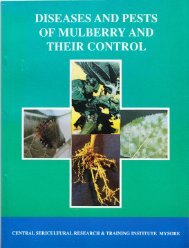
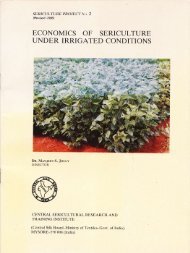
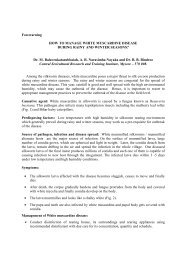
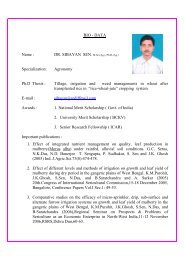
![E}A]\GALORE](https://img.yumpu.com/54052619/1/190x260/eagalore.jpg?quality=85)
